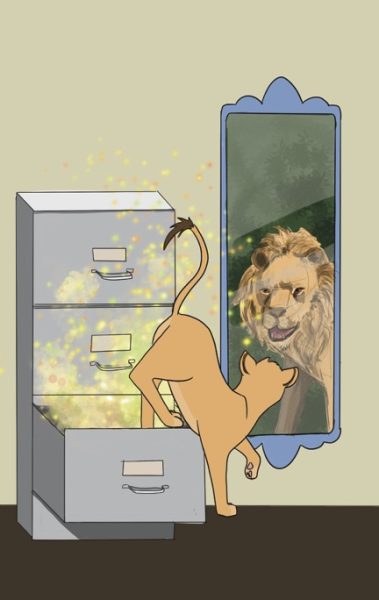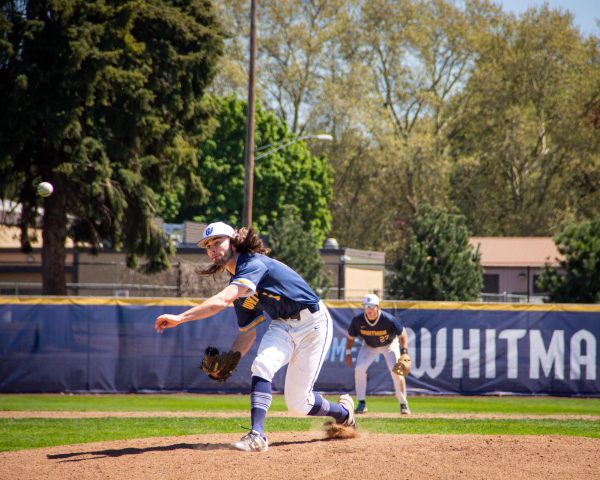Review: The NeverEnding story of the borderlands with LROD
March 10, 2022
LROD, an ‘artivist’ from El Paso and the Texas-Mexico borderland, performed at Whitman on March 5, showcasing their latest project. Their most recent research looks at movement as well as their ongoing relationship with the borderlands—how it has made them who they are today, and how it continues to motivate their work going forward.
The border, as commonly understood, conjures visuals of a physical boundary consisting of walls or fencing. LROD’s understanding of the borderlands is more abstract, stretching over miles and extending into the idea of movement itself. Existing in the borderlands forces entire communities into a constant struggle with border patrol.
Activism through art involves bringing visual passion to a movement or ideal that you care about; it is about displaying every emotion you have felt in your own experiences and using it to create change. When done successfully, artivists leave their audience feeling as much emotion as they do, even if audience members only know the basics about the background of the art.
LROD uses videography, dance and emotive speech to present their research, with the night’s performance opening with a multimedia interpretative tech video. LROD’s use of music, colors and dance formed an unsettling message that immediately hit the deathly silent audience. The video, while not explicitly stating exactly what LROD was trying to convey, used kaleidoscopes and visual effects to create an almost psychedelic ordeal. The expansion and compression of a shadow in the center of the screen spoke of the Borderlands collapsing in on itself before coming back, folding, unfolding, shaping itself as each day passes. Every flash of the video represented some part of LROD’s experiences in the Borderlands and the presence they understand it to have in the modern day world.
Following the video, the dance itself started after a moment of darkness. The screen rose to reveal LROD dressed in dark clothes and a striking mask, already moving to the tune of The NeverEnding Story. They performed their initial sequence toward the back of the room, each element within the choreography designed to shock us into a more receptive mindset. The routine did not follow typical steps; LROD used sudden movements to each beat, with every twist encouraging us to question what was being said. The flashing lights and LROD’s distance from the audience left them as an almost silhouette, enhancing each action and bringing even the most minor details into the center stage.
The room returned to darkness before revealing LROD to have moved to the upper-deck, looking down at a disoriented audience. This next part of the dance was performed to LROD’s own words, voice-changed to a deep, masculine tone. They questioned some of the assumptions we hold about the Borderlands, some of the stereotypes that allow us to draw on an image of the border that does not accurately reflect real life. LROD spoke of using “movement as a way of knowing,” with each segment of choreography piecing together their message and challenging those of us watching to search for our own understanding of their research.
The final few routines brought LROD back down to the audience where they performed directly in front of the stands. In this, music and speech came together and cumulated in LROD taking off their mask for one final dance. The raw emotion portrayed on their face, mixed with a sudden complexity of movement created a finale that you could not forget as you made your way out of the theater.
The discussion that came after the show brought to light some of the intense decisions LROD had to make when designing the performance. They spoke about how it had to sit in the present moment and reach actual conversations about moving forward while still using imagination to think about the future. They were tempted by how easy it would be to make the border disappear in the video; however, they realized that this would be moving into a utopian space.
The show reflected this desire to remain grounded in reality. You could clearly see their portrayal of refugees and immigrants reaching the border; you could see how they would fight to get across and yet would be resisted every step of the way by the relentless border control. You could see how the border impacted LROD’s own understanding of border movement as well as their questioning of the constant surveillance throughout the Borderlands. LROD masterfully creates a dance that appears improvised while simultaneously clearly articulates an advanced call for people to better their understanding of the border.
LROD admitted that they are still trying to figure out the message they are trying to convey and that they are doing this through their dancing. While this uncertainty is not evident in their performance at Whitman, it will be interesting to see how LROD’s work progresses as their own understanding of the border adapts.
To see more of LROD’s work, you can visit their website or follow them on social media.






